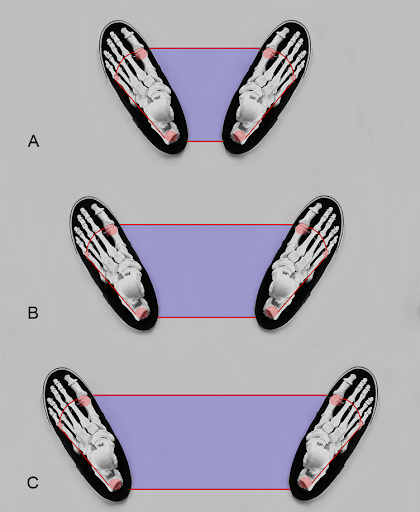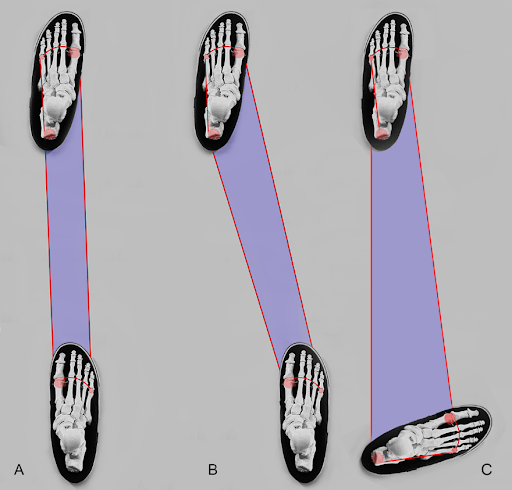Every time we move our bodies or our bodies and a load, we are, directly or indirectly, affected by gravity, and we use the Earth as our base. We produce muscular force to create distance between the segments of our body and the ground when we move from an original starting point to a different position. This means we need to orient our body to effectively and efficiently exert the force created by the muscles to move our own skeleton, and any weighted object we hold, to create the desired end result according to the very basic laws of physics (no math required).
Starting points are important, and in our case here, the starting point is our foot stance, our interface with the Earth. Stance is important, as it imparts stability, creates the parameters for force transference, and sets the stage for every subsequent movement’s execution during a specific exercise. But before we start analyzing stances for any exercise, we need to consider the basics of our standing stance, just simple run-of-the-mill standing.
Anatomically, humans are built for efficient standing. To maintain the body in an upright stationary position, the body has to maintain an equilibrium of forces applied to the skeleton’s vertical axis; front-back, side-side, and all the angles between. A number of anatomical features facilitate maintenance of this seemingly effortless balancing of the body.
The anatomical structure of the hip joint, specifically the junction of the femur at the acetabulum, is an excellent example of form facilitating this balancing function in an efficient manner. The iliofemoral ligaments (one on each hip) are among the strongest and most important ligaments in the body. In a standing position, the iliofemoral ligament receives the tension of the upper body weight (head, torso, and arms) and settles into an orientation that prevents falling backward, and it does so with virtually no requirement of muscular activity. Essentially the upper body is “hanging” on and between these two ligaments. The weight of the trunk is transmitted down through the pelvis to the acetabulum and a counterforce is transmitted up through the leg to the femoral head. The iliofemoral ligaments connect the two segments of the system and keep them in a stable proximity to each other. The end result is a balanced force across the hip and a postural position that can be maintained with only minor accessory muscular activity.
Somewhat similarly, at the knee there is a mechanism by which the need for muscular exertion is reduced with knee lock in relaxed standing. As with the hip, ligaments are important, but they act when the knee joint extends slightly beyond vertical. At this terminal extension, the knee joint becomes stabilized by the cruciate (anterior and posterior) and collateral (medial and lateral) ligaments. The partnership of the bony alignment and ligamental tension reduces but does not eliminate the need for minor and periodic muscular contraction during standing.
Further, the center of mass is stabilized above the area of base — the space under and between the feet — through additional actions at the ankle. The bony and ligamentous structure of the ankle and foot create a relatively restricted range of motion. Medial-lateral stability is robust without significant muscular exertion. However, as there is much more instability along the anterior to posterior surfaces, musculotendinous tension is requisite to minimizing anterior-posterior body sway. The closer the center of mass is to the center of the area of base, the lower the amount of muscular activity needed during relaxed standing. As the center of mass tends to creep slowly forward within the area of base over time when standing still, the plantar flexors (gastrocnemius, soleus) reflexively, cyclically, and gently contract to produce extending force that brings the center of mass back to center.
But in exercise we aren’t just standing, thus making our task of understanding what is going on a little more difficult. So, to start our exploration of exercise technique, we start at the floor-foot interface, as we need to consider the creation of the foundation of balance: the foot stance.
It is quite logical and physically correct to consider a narrow stance less stable than a wider stance. Balancing on a single foot is inherently more difficult than balancing on two feet. You can stand for hours on two feet and not lose balance, but most people cannot last more than a few seconds to minutes trying to balance on one foot. As you move your feet closer together, your stance more closely approximates standing on a single foot. The larger the area of base, the more stable the object. A pyramid has a significant area of base, but an equivalent mass sphere only has a single point within its area of base. Which is easier to move?
The same principle is in action when we stand. Simply pointing the toes outward can increase the area of base.

Figure 1
Figure 1: The area of base can be visualized according to the pressure points of the foot. (A) The major points of support (red dots) are to the anterior under the head of the first metatarsal, just behind the great toe, and to the posterior under the calcaneus, the heel bone. The heads of metatarsals 2 through 5 provide little support in normal standing posture. (B) When considering both feet placed side by side, the area of base is larger and includes the space between the feet (violet shading). This improves stability of stance. (C) Pointing the toes out 15o and keeping the heels the same distance apart increases the area of base by virtue of increasing the area between the forefeet. (D) Similarly, pointing the toes out 30o increases the side-to-side area significantly while minimally reducing the anterior to posterior boundaries of the area of base. This means lateral stability is improved but anterior-to-posterior stability begins to reduce. (E) Increasing foot angle to 45o further increases lateral stability at the expense of anterior-posterior stability. Note: The angles referred to above are for each foot’s external rotation away from the anterior-posterior midline of the body.
We can see this in action in bodyweight exercises such as yoga. It is a given that the simple horse stance (this is not referent to Vatayanasana) with feet wide apart is a more stable pose than the single-foot base tree posture (Vrikshasana) or the feet-together chair posture (Utkatasana). We can utilize this understanding to create safer and more achievable posture adjustments for our trainees in CrossFit based on their level of training and balance ability. An obvious stance adjustment for trainees with balance issues (beginners, the aged, or any population where balance may be compromised) is simply to widen foot placement to enlarge the area of base (Figure 2). We initially increase the lateral distance between the feet and improve stability. Over time, we then work to narrow that distance as balance improves.


